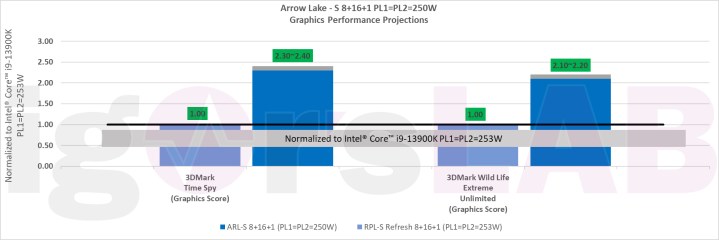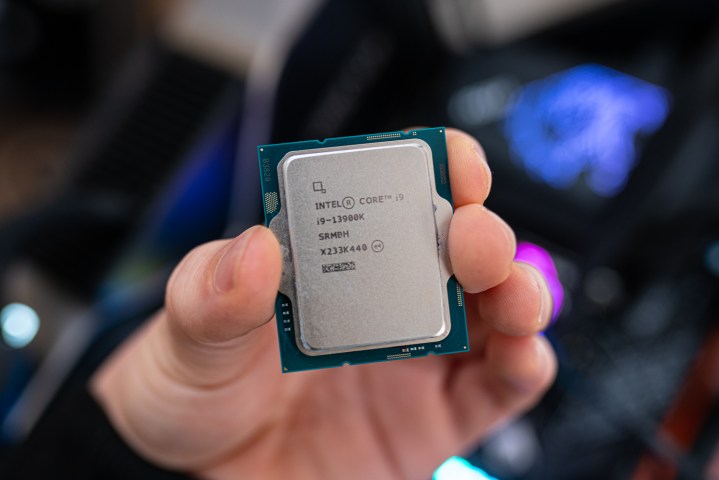Intel’s powerful CPUs won’t be coming out until 2024
Intel’s next two generations of desktop CPUs are both exciting and confusing. Luckily, new information has come to light around what to expect.
The report comes from German publication Igor’s Lab, which claims to have seen Intel’s internal performance projections for these next two generations of chips. The report also affirms some of the details in Intel’s desktop road map, including that the 14th-gen fall release will be a Raptor Lake Refresh rather than true Meteor Lake desktop chips. It also says the 15th-gen Arrow Lake is anticipated to launch in 2024.
To ensure a fair comparison, Intel has used the current-gen Core i9-13900K for normalization with corresponding models of Raptor Lake Refresh and Arrow Lake. It is important to note that these numbers are just an estimate and will potentially differ from the final performance numbers of the upcoming CPUs.
All three processors share the same configuration, with eight performance cores and 16 efficiency cores. The numbers also suggest that Arrow Lake will consume almost the same power as Raptor Lake. The PL1 and PL2 for Raptor Lake and Raptor Lake refresh is set to 253 watts, while Arrow Lake is set to 250W.

The first graph suggests that Raptor Lake Refresh will offer a performance increase between 1% to 3%, which will be primarily due to increased clock speeds that are expected to go as high as 6GHz. Arrow Lake, on the other hand, delivers a 7% to 20% performance increase, where the highest improvements are set to be in multi-core operations.

The next slide focuses on the SPEC CPU benchmark package that contains standardized, CPU-intensive suites for measuring and comparing compute-intensive performances. This ensures a comparative measurement of compute-intensive performance across broad a spectrum of hardware using workloads derived from real user applications. Here, Raptor Lake Refresh experences a gain of 1% to 4%, depending on the application. Arrow Lake gains performance ranging from 3% to 21%, which is a significant jump, specifically in the floating-point runs.

The last graph gives us information about the integrated graphics. Raptor Lake Refresh uses the same HD 700 series GPU as the Core i9-13900K, with 32 EUs and clock speeds of up to 1.65GHz. Since both are using the same configuration, the performance is also similar. However, Arrow Lake will be using the new Xe LP graphics, and will also be the first desktop CPU where the integrated GPU is mounted using Foveros packaging that stacks chipsets vertically. While there is no confirmation around the number of EUs or the clock speeds, the slide suggests an impressive increase of 220% to 240% compared to the 100% of Raptor Lake.
Arrow Lake is also expected to arrive with a new socket that is rumored to be LGA1851. While the dimensions of the socket are expected to be similar to the LGA1700, it will have 9% more pins. Thus, Intel should introduce motherboards with 800-series chipsets. As for cooler manufacturers, they might need to introduce new mounting hardware once again. Of course, none of this information is final and could change at the last minute.
Editors’ Recommendations

Intel’s next two generations of desktop CPUs are both exciting and confusing. Luckily, new information has come to light around what to expect.
The report comes from German publication Igor’s Lab, which claims to have seen Intel’s internal performance projections for these next two generations of chips. The report also affirms some of the details in Intel’s desktop road map, including that the 14th-gen fall release will be a Raptor Lake Refresh rather than true Meteor Lake desktop chips. It also says the 15th-gen Arrow Lake is anticipated to launch in 2024.
To ensure a fair comparison, Intel has used the current-gen Core i9-13900K for normalization with corresponding models of Raptor Lake Refresh and Arrow Lake. It is important to note that these numbers are just an estimate and will potentially differ from the final performance numbers of the upcoming CPUs.
All three processors share the same configuration, with eight performance cores and 16 efficiency cores. The numbers also suggest that Arrow Lake will consume almost the same power as Raptor Lake. The PL1 and PL2 for Raptor Lake and Raptor Lake refresh is set to 253 watts, while Arrow Lake is set to 250W.

The first graph suggests that Raptor Lake Refresh will offer a performance increase between 1% to 3%, which will be primarily due to increased clock speeds that are expected to go as high as 6GHz. Arrow Lake, on the other hand, delivers a 7% to 20% performance increase, where the highest improvements are set to be in multi-core operations.

The next slide focuses on the SPEC CPU benchmark package that contains standardized, CPU-intensive suites for measuring and comparing compute-intensive performances. This ensures a comparative measurement of compute-intensive performance across broad a spectrum of hardware using workloads derived from real user applications. Here, Raptor Lake Refresh experences a gain of 1% to 4%, depending on the application. Arrow Lake gains performance ranging from 3% to 21%, which is a significant jump, specifically in the floating-point runs.

The last graph gives us information about the integrated graphics. Raptor Lake Refresh uses the same HD 700 series GPU as the Core i9-13900K, with 32 EUs and clock speeds of up to 1.65GHz. Since both are using the same configuration, the performance is also similar. However, Arrow Lake will be using the new Xe LP graphics, and will also be the first desktop CPU where the integrated GPU is mounted using Foveros packaging that stacks chipsets vertically. While there is no confirmation around the number of EUs or the clock speeds, the slide suggests an impressive increase of 220% to 240% compared to the 100% of Raptor Lake.
Arrow Lake is also expected to arrive with a new socket that is rumored to be LGA1851. While the dimensions of the socket are expected to be similar to the LGA1700, it will have 9% more pins. Thus, Intel should introduce motherboards with 800-series chipsets. As for cooler manufacturers, they might need to introduce new mounting hardware once again. Of course, none of this information is final and could change at the last minute.
Editors’ Recommendations
